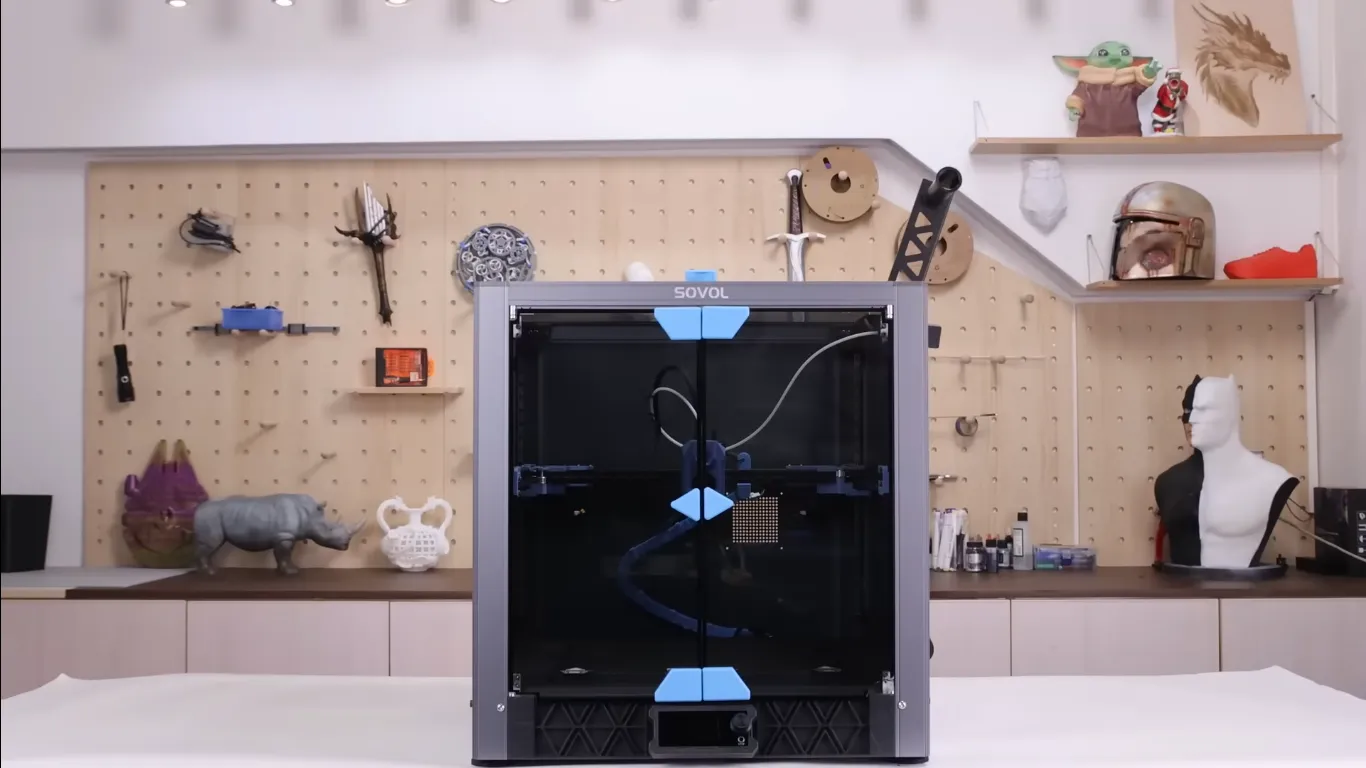The Sovol SV08 stands at an intriguing crossroads in the 3D printing world, bridging the gap between consumer-friendly machines and high-end, DIY kits. The SV08 aims to provide speed and precision without making a massive dent in your wallet as it features out the consistent 350 x 350 x 345mm build volume and CoreXY design established on the prevalent Voron 2.4. As a longtime 3D printing enthusiast who has spent many hours tweaking on my own machines, I was excited to bench test this machine and see if it could live up to the hype.
After weeks of rigorous testing, I’m ready to share my honest review of this speed demon. While it may not top every list of the best 3D printers, the Sovol SV08 absolutely warrants serious consideration if you’re in the market for a large-format printer that combines blistering speed with open-source flexibility. Read on the detailed review and find out did it meet our expectations.

First Impressions and Setup
Right out of the gate, the Sovol SV08 impresses with its thoughtful packaging and streamlined assembly process. Sovol promises a quick setup for its 3D printer, unlike other DIY kits that can take days. I was initially doubtful, but I found their claim to be pretty accurate. You can have this printer ready to use in about an hour.
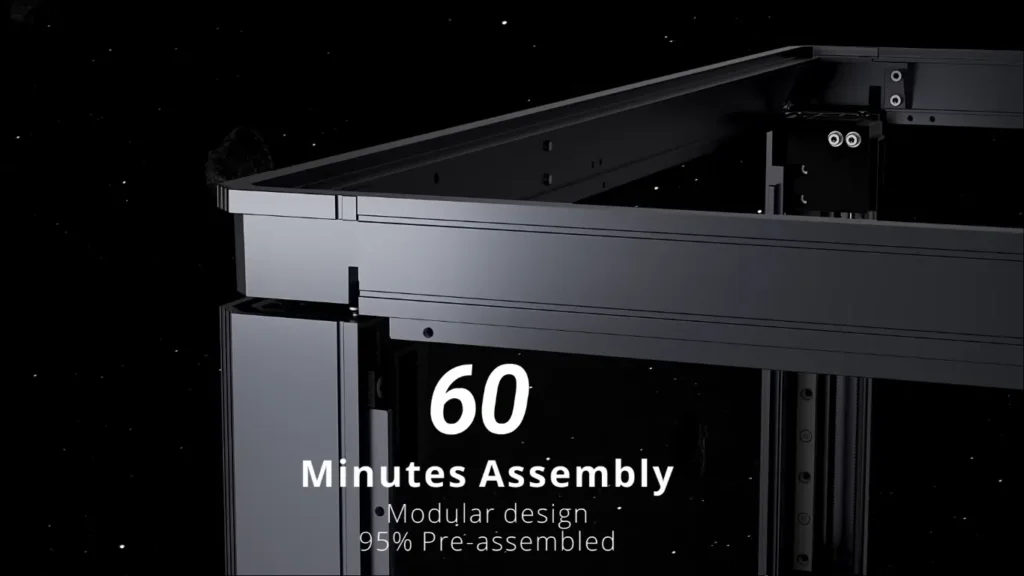
The unboxing experience is a bit like wrestling a bear – this printer is hefty and densely packed. But once you’ve got everything laid out, the assembly is surprisingly straightforward. The Z-axis units come pre-assembled, which is a huge time-saver. The flying gantry, while a bit unwieldy, slots into place without too much fuss. One tip: while the included Allen keys will get the job done, having a good screwdriver with hex bits on hand will make your life much easier.
In my case, I had the printer assembled and ready to go in about 45 minutes. This included attaching the screen, filament holder, and making all the necessary wire connections. It’s a far cry from the multi-day builds some enthusiasts endure for high-end printers.
PROS
+ Lightning-fast prints
+ Huge build volume
+ Easy to set up
+ Great value for money
+ Open-source design
CONS
− Can be noisy at high speeds
− Wi-Fi setup is a bit clunky
− Some inconsistencies in first layer height
− Limited flexible filament performance
Design and Build Quality
The Sovol SV08 doesn’t just talk the talk; it walks the walk when it comes to build quality. This printer feels solid, with a sturdy metal frame that promises stability during those high-speed prints. The use of linear rails on all axes is a nice touch, typically found on more expensive machines.

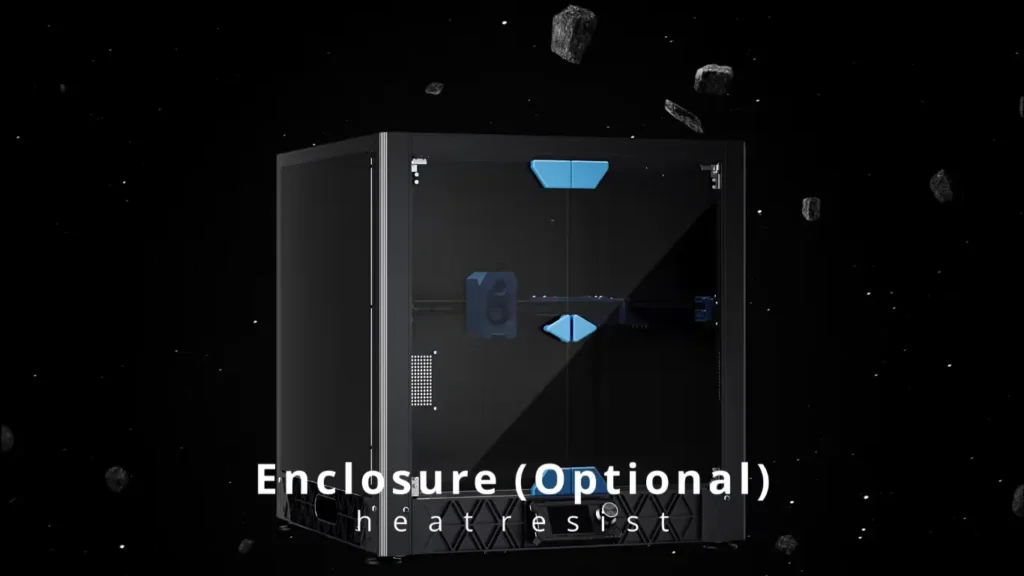
One of the standout features is the generous build volume of 350x350x345mm. That’s a lot of printing real estate, especially considering the Sovol SV08’s price point. The removable magnetic print bed is a joy to use, coated with a durable PEI-like surface that grips prints firmly when hot and releases them easily as it cools.
Sovol has clearly put thought into the user experience. The printer features built-in handles for easy moving (trust me, you’ll appreciate this given its size), and the magnetically attached toolhead cover adds a touch of polish. The bed alignment tabs are a small but welcome addition, making it easy to get that perfect first layer.
Speed Meets Precision
At the heart of the Sovol SV08 is its CoreXY design, inspired by the popular open-source Voron 2.4. This setup, combined with the printer’s quad gantry leveling system, promises speed and precision in equal measure.

The hotend is a proprietary design, featuring a 0.4mm nickel-plated nozzle capable of reaching temperatures up to 300°C. In my testing, I consistently achieved flow rates of 25-27 cubic mm/s with PLA at 220°C – impressive numbers that translate to some seriously speedy prints.
Cooling is handled by a 5020 blower inside the toolhead, supplemented by an extra 4010 blower at the back. This dual-fan setup ensures your prints cool quickly, which is crucial for maintaining quality at high speeds.
One feature that caught my eye is the built-in ADXL accelerometer for resonance compensation. This is typically an aftermarket upgrade for many printers, so seeing it included out of the box is a nice touch.
Getting Connected
Here’s where things get a bit… interesting. The Sovol SV08 comes with a basic monochrome LCD and click wheel interface. It’s functional, but in an age of touchscreens, it feels a bit dated. Sovol offers a $99 upgrade to a color touchscreen, which might be worth considering if you prefer a more modern interface.

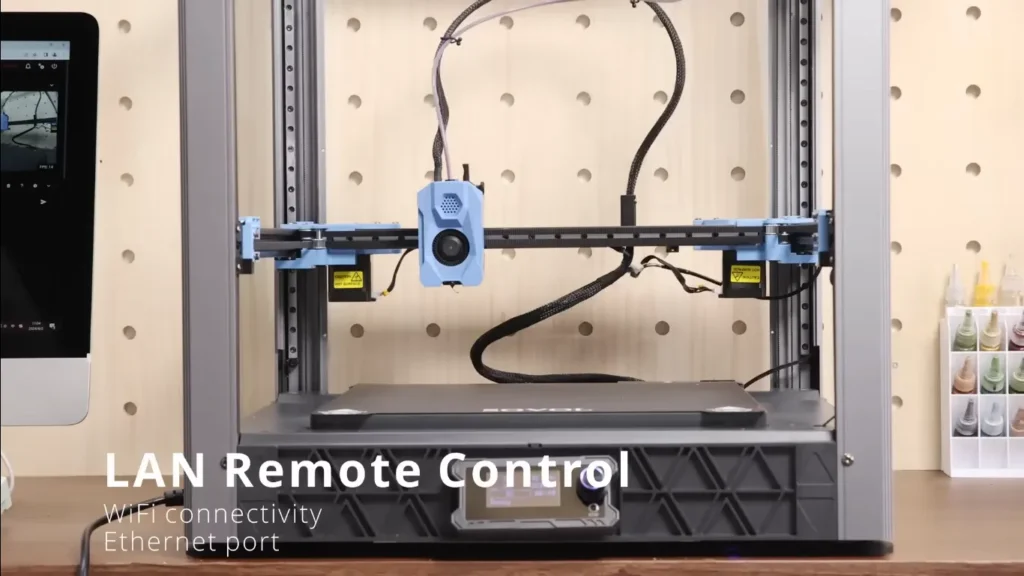
Wi-Fi connectivity is included, but setting it up was more challenging than it needed to be. The process involves loading Wi-Fi details onto a USB drive – a bit old-school for my taste. Once connected, though, you can control the printer remotely via a web interface, which is handy for monitoring prints through the built-in webcam.
Printing Performance
Now, let’s get to the meat of the matter – how does this thing actually print? In short: fast. Very fast. The Sovol SV08 consistently set new speed records in my benchmark tests, often outpacing printers costing twice as much.
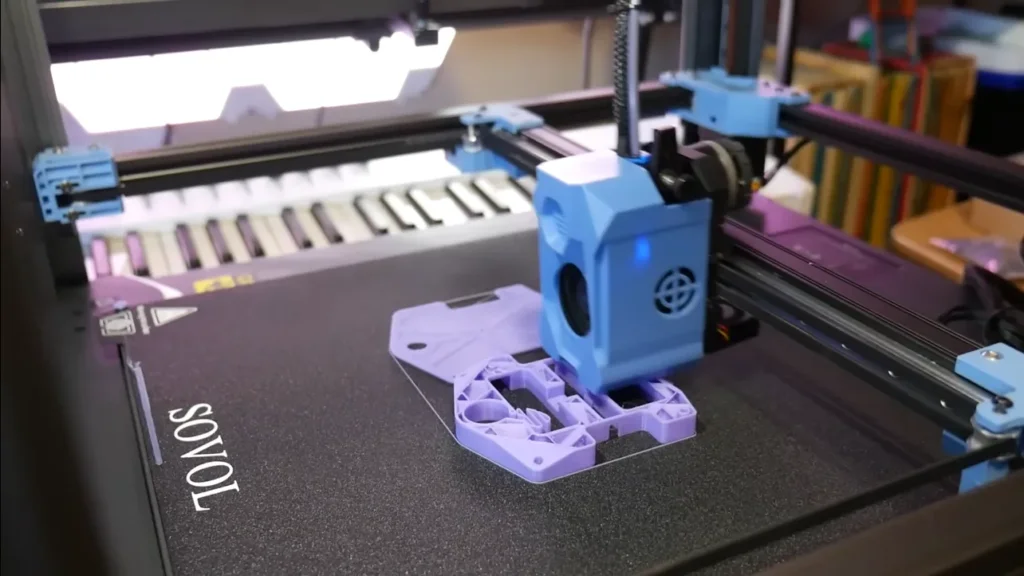

Print quality at these high speeds is generally good, though not without some trade-offs. Surface finish isn’t quite as polished as you might get from slower, more meticulously tuned machines. Despite this, the prints were consistently accurate and precise in terms of their dimensions.
I tested the Sovol SV08 with a range of materials, including PLA, PETG, TPU, and carbon fiber-filled nylon. PLA prints were exceptional, featuring crisp details and minimal stringing. PETG adhered well to the bed and produced strong, functional parts.
TPU was a bit of a mixed bag. The printer handled TPU better than anticipated for a high-speed machine, but there were occasional extrusion inconsistencies that needed adjustment. This is common with flexible filaments and should be considered if you intend to print a lot of TPU.

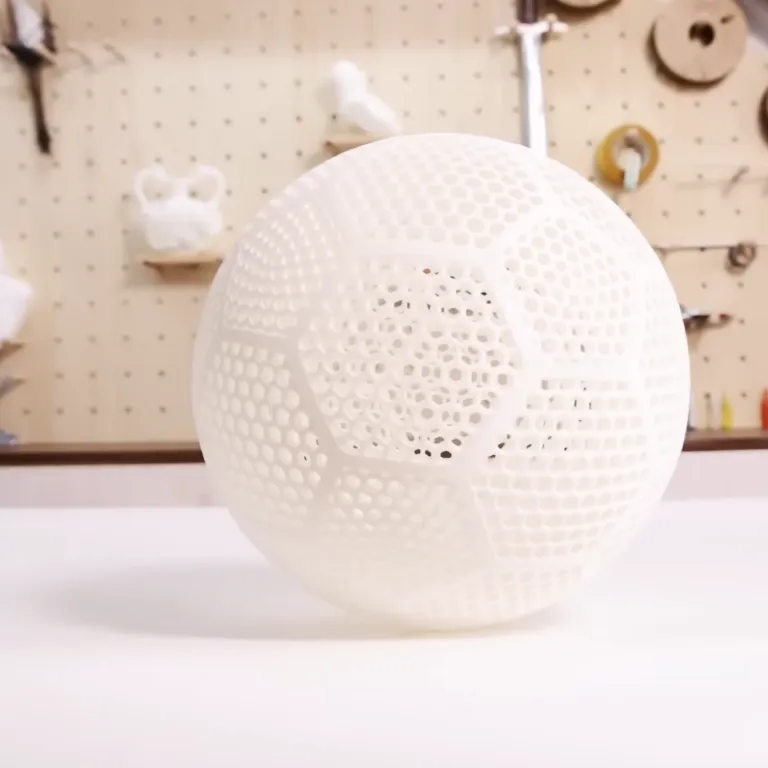
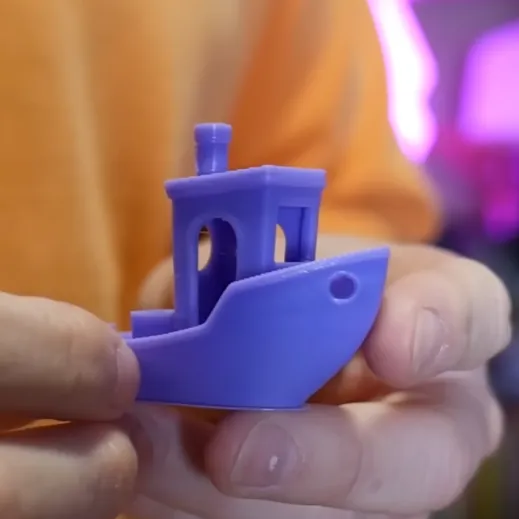
The printer’s ability to handle high-temperature materials like ABS and polycarbonate was truly impressive. The heated bed, reaching 100°C, ensured excellent adhesion for these challenging filaments. However, for best results with these materials, you’ll want to invest in the optional enclosure panels to maintain a stable printing environment.
One quirk I noticed during testing was some inconsistency in the Z-offset calibration. This occasionally led to first layer issues, requiring manual adjustments. It’s not a major issue, but something to be aware of, particularly when changing materials.
Software and Firmware
The Sovol SV08 comes pre-loaded with Klipper firmware, which is a big plus for speed and precision. The printer arrives with a solid baseline configuration, including features like adaptive meshing and support for timelapses.
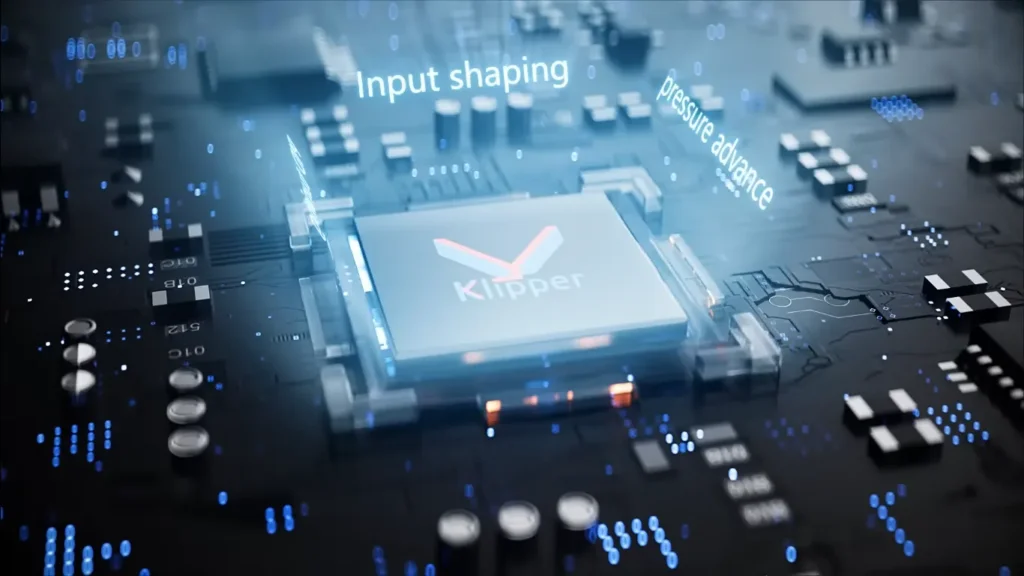
While this printer is a great starting point, there’s always potential for improvement. The dedicated community is already working on ways to fine-tune its settings and software, and I anticipate seeing exciting developments in the near future.
One area that could use some attention is the default print profiles. While they provide a decent foundation, I found myself making numerous tweaks to achieve the optimal print. This isn’t surprising for a new printer, but it’s worth considering if you’re not comfortable with slicer customization.
Open Source Advantage
Sovol’s SV08 stands out in a market dominated by closed, proprietary systems. Their commitment to open source is refreshing. The have released the firmware, engineering drawings and even a full CAD model to the community.
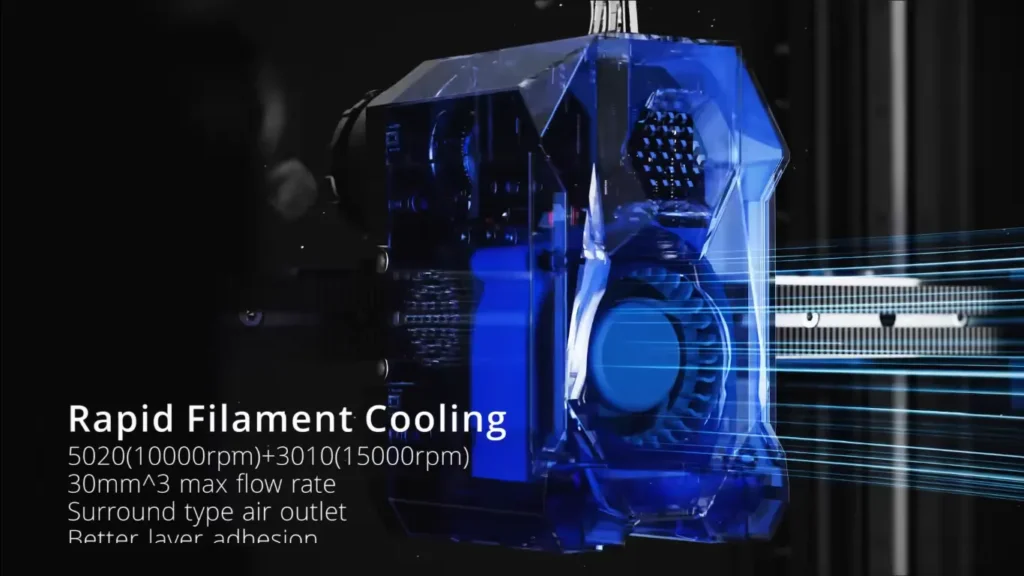

The flip side of this openness is that it exposes the whole stack. First, it brings in an infinite scope of customization and refinement. On the other, some parts of the printer, like the unique nozzle design and mainboard, are proprietary. This could limit certain modifications and may tie users to Sovol for some replacement parts.
Noise Levels
Let’s address the elephant in the room – or should I say, the jet engine in the room? The Sovol SV08 is not a quiet printer, especially when it’s really cooking. The powerful cooling fans, while crucial for maintaining print quality at high speeds, contribute significantly to the noise level.

In testing, I found noise levels between 55 and 65 dB depending on print speed and cooling demands. It’s not deafening, but it’s certainly noticeable. If you’re going to use this printer in an inhabited room, some additional sound dampening or destined printing space might be needed.
Sovol SV08 Specifications Chart:
| Feature | Specification |
|---|---|
| Build Volume | 350 x 350 x 345 mm |
| Print Speed | Up to 700 mm/s |
| Nozzle Temperature | Up to 300°C |
| Bed Temperature | Up to 100°C |
| Filament Compatibility | PLA, PETG, TPU, ABS, PC, Nylon |
| Connectivity | Wi-Fi, USB |
| Interface | LCD screen with click wheel (touchscreen optional) |
| Frame | Metal with linear rails |
| Extruder | Direct drive |
| Firmware | Klipper |
| Camera | Built-in for print monitoring |
| Assembly Time | ~1 hour |
| Bed Leveling | Automatic quad gantry leveling |
| Flow Rate | 25-27 cubic mm/s (PLA at 220°C) |
Upgrade Potential
While the Sovol SV08 is impressive out of the box, there are a few areas where future upgrades might be beneficial:
- Enclosure: Sovol plans to release optional enclosure panels for $100-150. This will be a must-have for anyone looking to print high-temperature materials consistently.
- Touchscreen: The basic LCD works, but the touchscreen upgrade could significantly improve the user experience.
- Nozzles: The stock nozzle performs well, but it’s not hardened. For those looking to print abrasive materials, aftermarket nozzle options would be welcome.
- Firmware Tweaks: As the community grows, expect to see custom firmware builds that may address some of the minor issues like Z-offset inconsistencies.
Value for Money
Now, let’s talk dollars and cents. Sovol SV08 is priced only at $579 that makes it one of the most competitive offers in terms of large-format and high-speed printers. It’s in a different league when you think of the build volume, print speed specifications and quality for its class.
During my testing, I found myself constantly comparing the Sovol SV08 to printers costing twice as much. While it may not match them in every aspect, the fact that it’s even in the conversation is testament to its value.
For those eyeing a Voron 2.4 build but balking at the time investment or cost, the Sovol SV08 offers a compelling alternative. You’re getting many of the benefits of a Voron-style printer without the headache of sourcing parts and spending days on assembly.
Community Support: A Nod to the Community
It’s worth noting that Sovol has pledged to donate $2 to the Voron project for each SV08 sold. This acknowledgment of the open-source roots of their design is a classy move and helps support the broader 3D printing community.
Final Thoughts
The Sovol SV08 is offered at a retail price of $579, which positions it as an incredibly competitive option in the large-format, high-speed printer market. When you factor in its impressive build volume, CoreXY design, and open-source nature, it’s clear that the SV08 offers exceptional value for money.
Purchased as a standalone unit, the sub-$600 Sovol SV08 offers an excellent experience as a fast, large-format 3D printer capable of handling a wide range of materials. However, to fully unlock its potential, you might want to consider some additional accessories like the optional enclosure or touchscreen upgrade, which will increase the overall cost.
It’s easy to recommend the Sovol SV08 as the machine to buy if you’re looking for a Voron-inspired printer without the hassle of sourcing parts and spending days on assembly. However, It is worth looking at our list of the best 3D printers if you prioritize ultra-quiet operation or need to print flexible filaments frequently; we included more specialized machines that may do a better job in those areas.
In the end, the Sovol SV08 represents an exciting step forward in affordable, high-performance 3D printing. It may not be the new king of any particular category, but it outpaces most of the top industry players in many categories with an impossible combination of speed, high print quality and low costs.
FAQs:
How long does it take to assemble the Sovol SV08?
Assembly typically takes about an hour, as most components come pre-assembled.
Can the Sovol SV08 print flexible filaments?
Yes, but performance may vary. It handles TPU, but some users report inconsistencies.
Is an enclosure necessary for the Sovol SV08?
An enclosure isn’t required but is recommended for printing high-temperature materials like ABS.
How noisy is the Sovol SV08 during operation?
It tends to get very loud at higher speeds, reaching noise levels between 55-65 dB.
Does the Sovol SV08 come with a touchscreen?
The base model has an LCD with a click wheel. A touchscreen is available as an optional upgrade.
Nikko Jenkins is a technology journalist based in the US, covering tool reviews and comparisons across North America, Europe and Asia, particularly 3D Printers. His concise, insightful articles on the latest innovations help readers worldwide make informed tech decisions. Jenkins’ expertise and engaging style have made him a respected voice in the global technology landscape.
Feel free to reach out to me at nikkojenkins@360techinsights.com.

